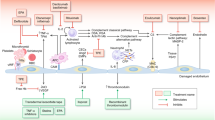Abstract
Purpose
Verify the recovery of visual capacity after the administration of a combination of LDL apheresis (LA) and conventional therapy (CT). Design, prospective and interventional case series.
Methods
20 patients affected by NAION were randomly subdivided into two groups of 10 patients (Group 1 and Group 2). Group 1 underwent three sessions of LA associated with CT, whereas group 2 received only CT. At discharge and at the 6 months follow-up visit, assessment in both groups was made of the best corrected visual acuity (BCVA) and the computerised visual field (CVF), comparing the findings with those at admission in each patient.
Results
Only the mean deviation (MD) at CVF was statistically improved in group 1 as compared with group 2 at discharge, judged against the values at admission (−11.08±6.51 vs −16.53±10.03, P=0.039; −17±5.24 vs −14.14±9.42, respectively). However, this increase was not confirmed at 6 months (−16.83±−10.72, group 1; −13.56±3.60 group 2).
Conclusion
In NAION, LA induced a short term improvement in the MD, but by 6 months this had disappeared.
Similar content being viewed by others
Main
In non-arteritic ischaemic optic neuropathy (NAION), insufficient blood circulation within the optic nerve head has been postulated as the cause.1, 2
In previous experiences, we have associated treatment with LDL apheresis and traditional therapy in patients affected by NAION, obtaining convincing results in terms of the improvement of functional parameters.3, 4, 5
In this study, 20 patients affected by NAION were randomly subdivided into two groups: a group of 10 patients treated with conventional therapy in combination with LDL apheresis (group 1) and a control group of 10 patients treated with conventional therapy only (group 2).
The comparison of the best-corrected visual acuity at admission, at discharge, and at 6 months in the two groups did not reveal any significant differences within groups and between groups at the times considered.
The mean deviation (MD) resulted statistically significantly improved in group 1 at discharge as compared with admission (P=0.039). However, the improvement did not persist up to 6 months, but returned to the values recorded at hospital admission. Instead, in group 2, the MD remained largely unchanged at all three times considered (Table 1).
The temporary increase in the functional visual parameters that we observed after apheresis seems to be attributable to an improvement in the haemorheologic parameters, sustained by a drastic reduction in the endothelial activation indexes.5 Moreover, an improvement in the MD was also observed in our previous experiences 4, 5 following treatment with LDL apheresis, but we did not prolong follow-up to 6 months. In this study, the return of the MD to the pretreatment values suggests that the temporary increase in MD could be sustained by reversible haemorheological improvements (reduced plasma and whole blood viscosity, reduced erythrocyte aggregability, and so on) obtained using LDL apheresis, that could have induced a short-term enhanced blood flow to the posterior ciliary arteries.
It has still to be seen how long these effects last and whether prolonged apheresis treatment, for more than the three sessions we administered, or repeated over time according to cycles that have still to be ascertained could achieve a definitive cure of NAION.
References
Arnold AC . Pathogenesis of nonarteritic anterior ischemic optic neuropathy. J Neuroophthalmol 2003; 23: 157–163.
Hayreh SS . Anterior ischemic optic neuropathy I: terminology and pathogenesis. Br J Ophthalmol 1974; 58: 981–989.
Ramunni A, Giancipoli G, Saracino A, Guerriero S, Saliani MT, Gentile MC et al. LDL-apheresis in acute anterior ischemic optic neuropathy. Int J Artif Organ 2004; 27: 337–341.
Ramunni A, Giancipoli G, Guerriero S, Lapenna L, Saracino A, Saliani MT et al. LDL-apheresis accelerates the recovery of nonarteritic acute anterior ischemic optic neuropathy. Ther Apher Dial 2005; 9 (1): 53–58.
Ramunni A, Ranieri G, Giancipoli G, Guerriero S, Ria R, Saliani MT et al. Is the efficacy of LDL apheresis in ischemic optic neuropathy linked to a reduction in endothelial activation markers? Blood Purif 2006; 063: 1–8.
Author information
Authors and Affiliations
Corresponding author
Rights and permissions
About this article
Cite this article
Guerriero, S., Giancipoli, G., Cantatore, A. et al. LDL apheresis in the treatment of non-arteritic ischaemic optic neuropathy: a 6-month follow-up study. Eye 23, 1343–1344 (2009). https://doi.org/10.1038/eye.2008.287
Received:
Revised:
Accepted:
Published:
Issue Date:
DOI: https://doi.org/10.1038/eye.2008.287
Keywords
This article is cited by
-
Treatment of nonarteritic anterior ischemic optic neuropathy with an endothelin antagonist: ENDOTHELION (ENDOTHELin antagonist receptor in Ischemic Optic Neuropathy)—a multicentre randomised controlled trial protocol
Trials (2022)
-
Lipoprotein(a) als wichtiger Risikofaktor für Gefäßverschlüsse. Bericht über eine beidseitige nicht-entzündliche anteriore ischämische Optikusneuropathie mit erfolgreicher Behandlung eines Auges und Langzeitbeobachtung
Spektrum der Augenheilkunde (2014)
-
Therapeutic apheresis in peripheral and retinal circulatory disorders
Clinical Research in Cardiology Supplements (2012)



